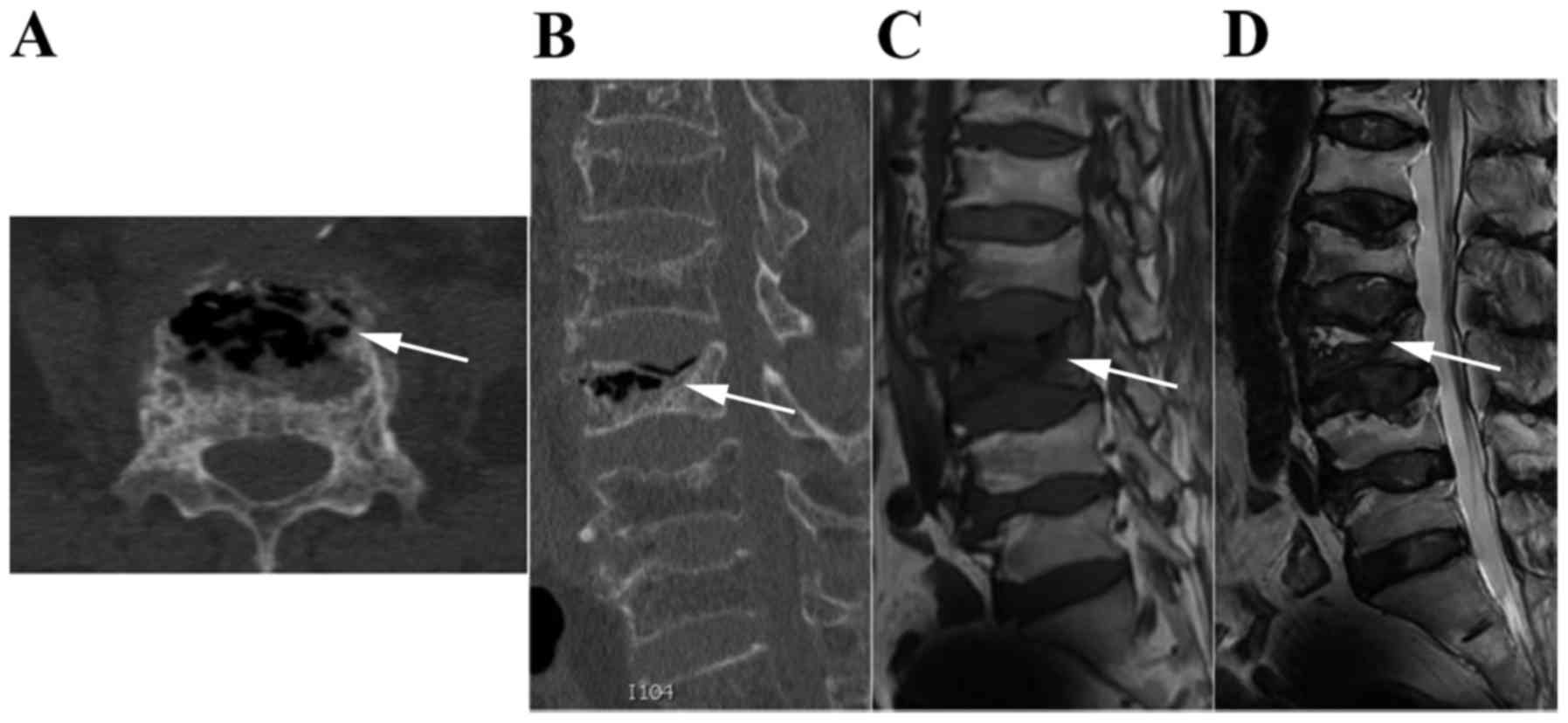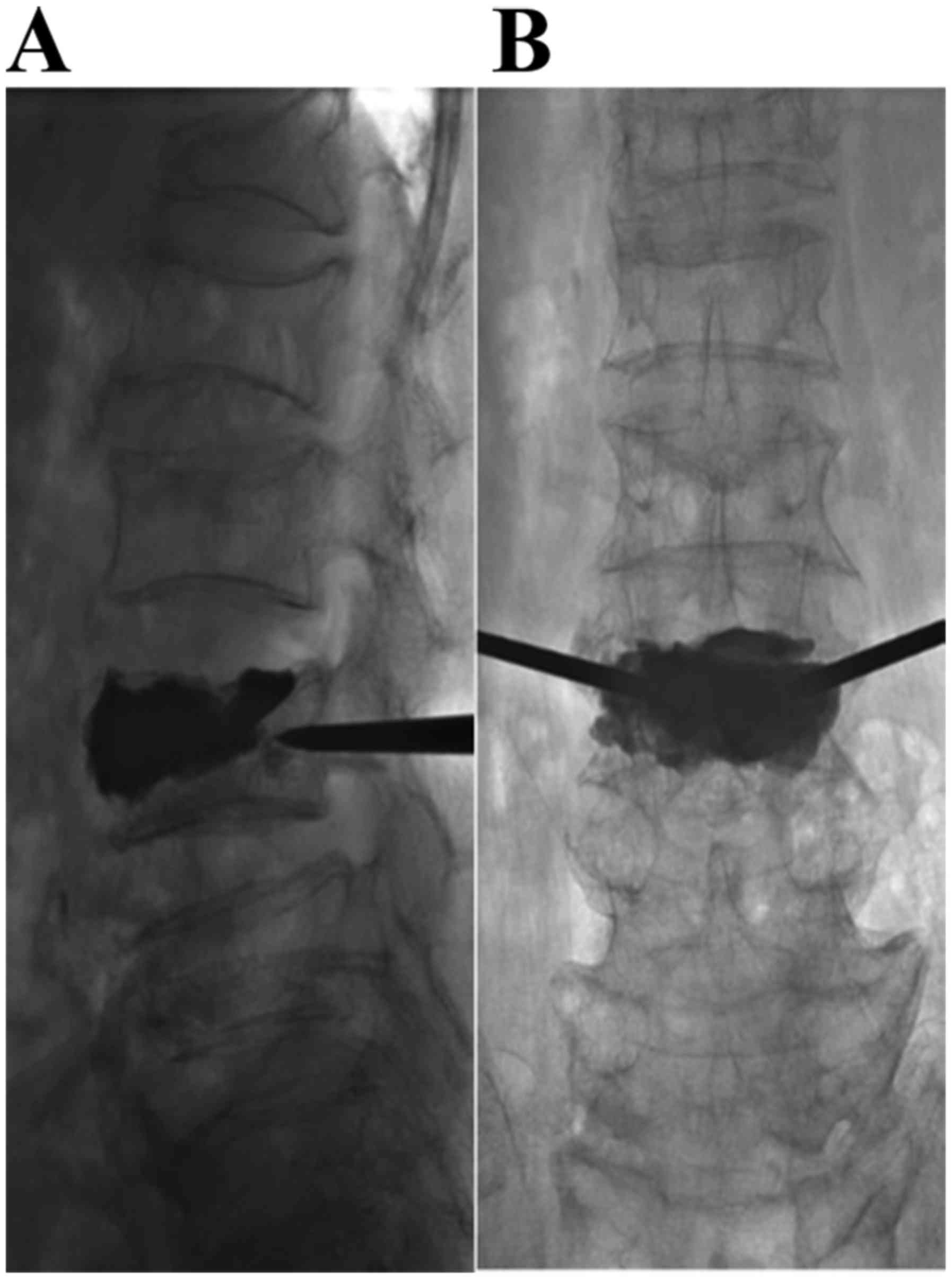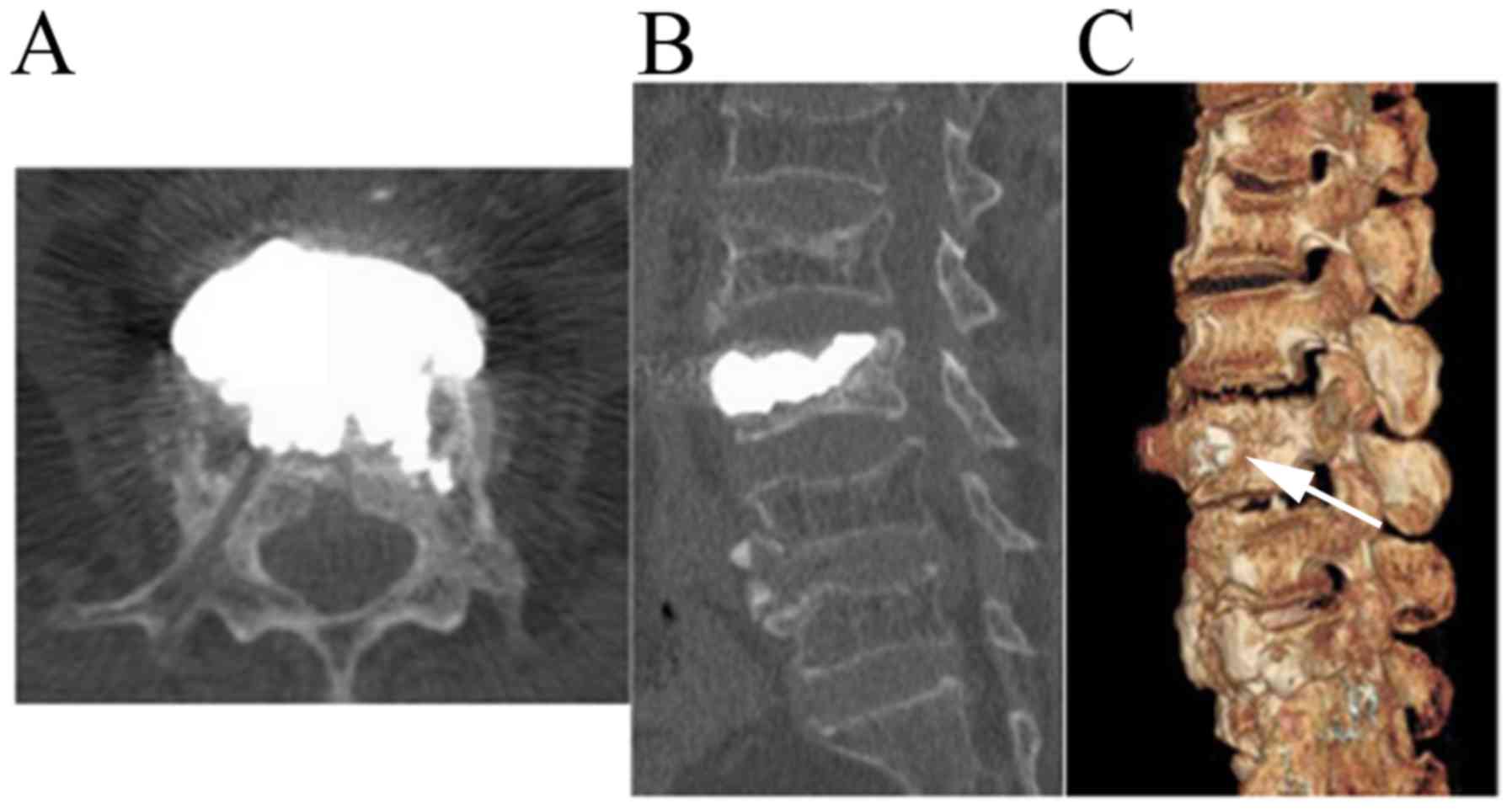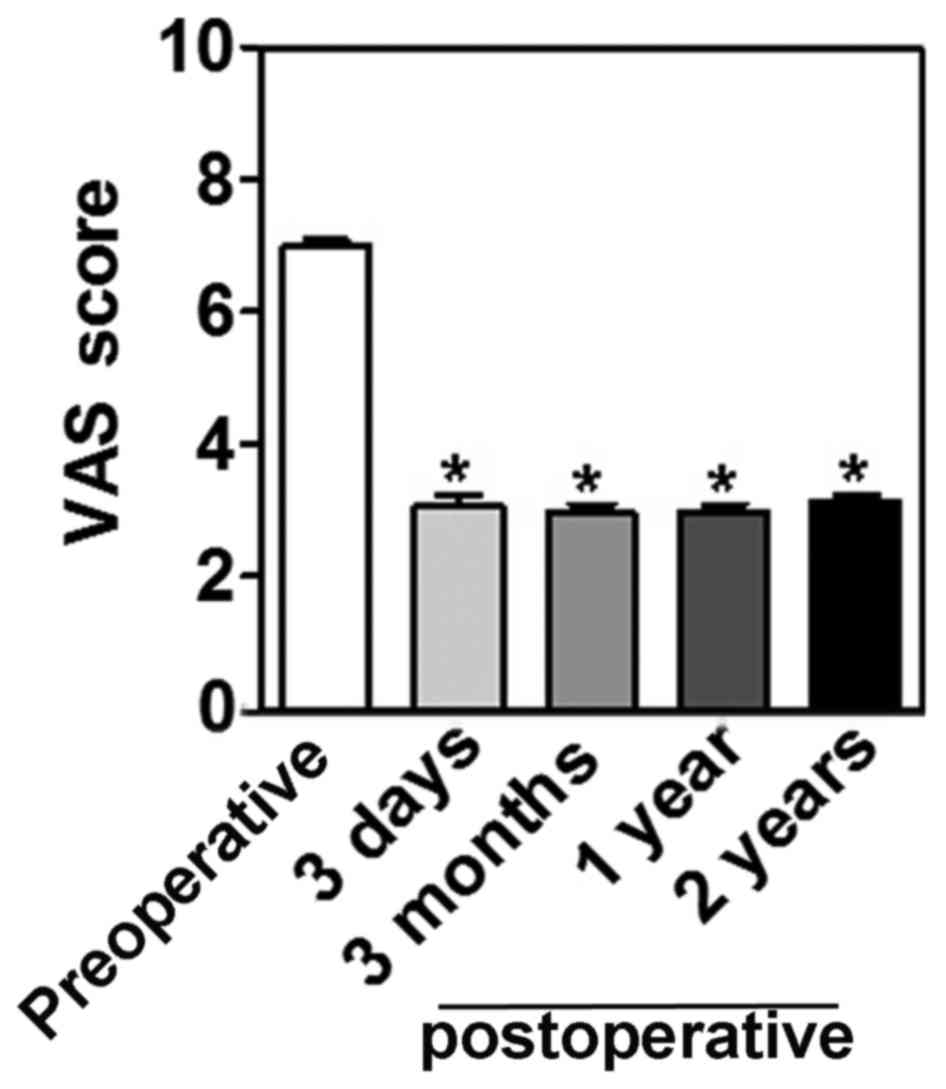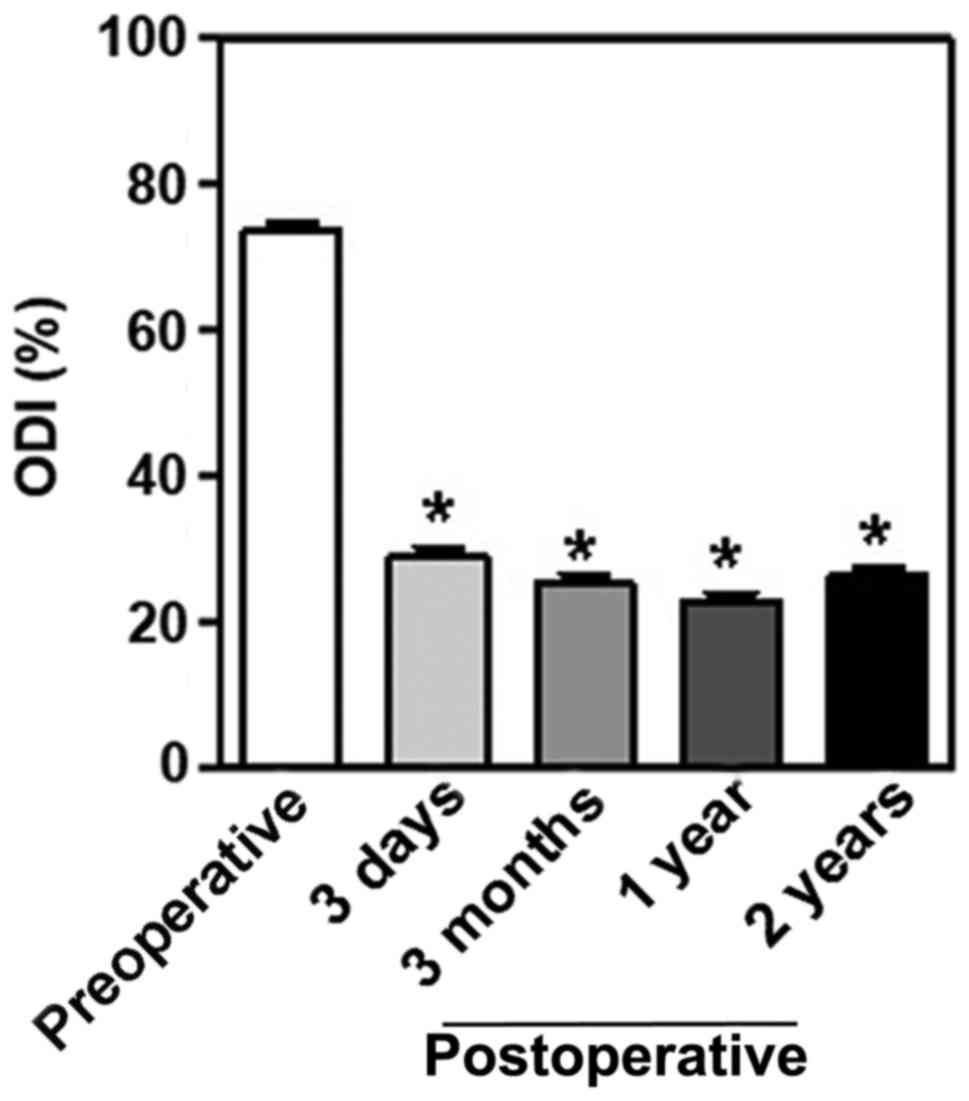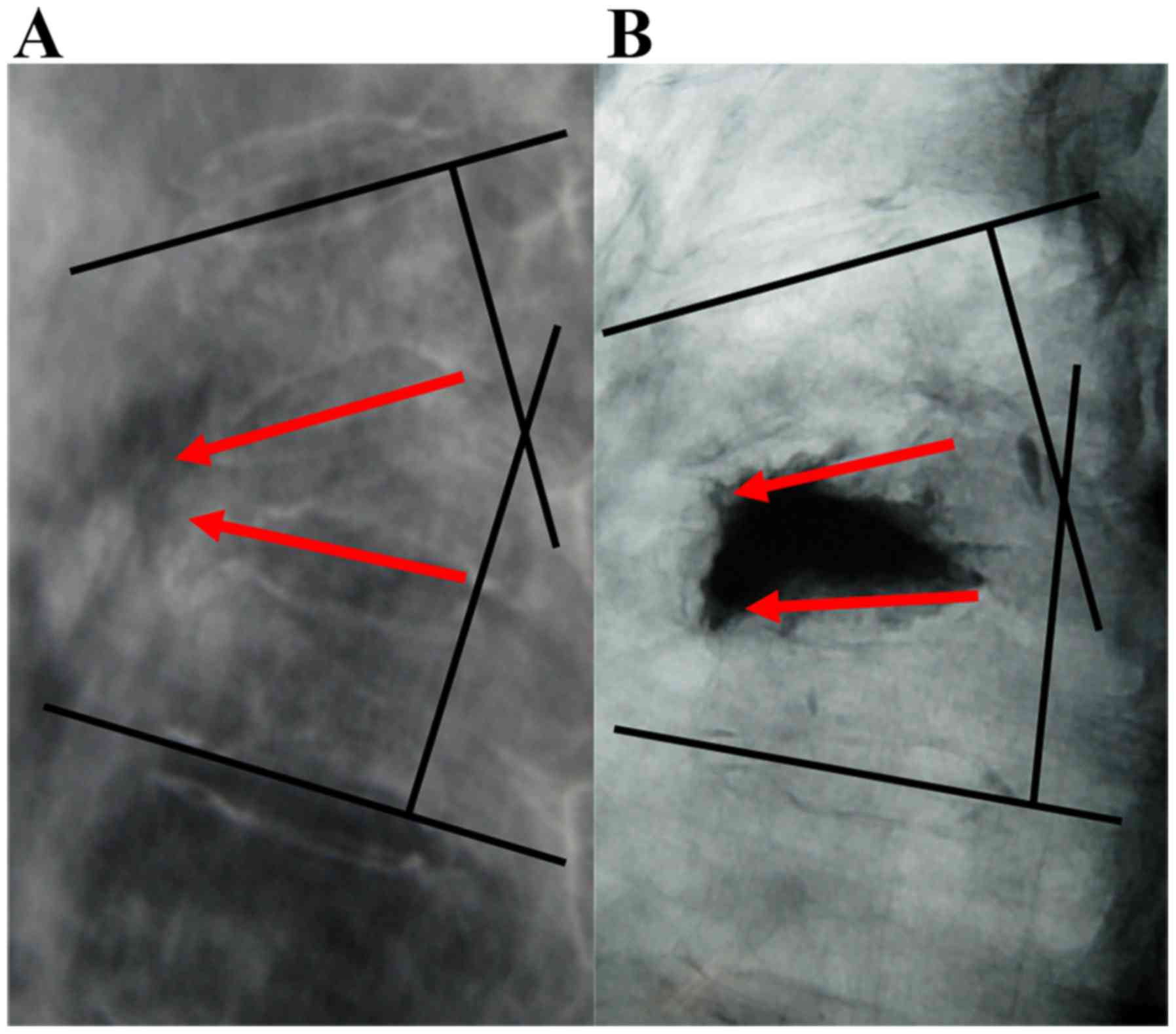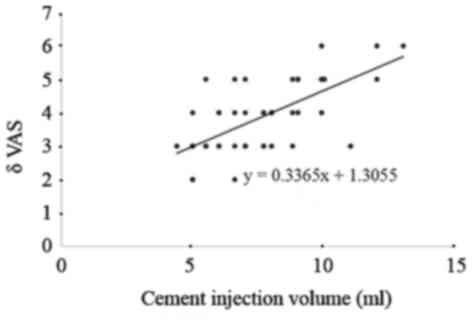|
1
|
Kim YC, Kim YH and Ha KY: Pathomechanism
of intravertebral clefts in osteoporotic compression fractures of
the spine. Spine J. 14:659–666. 2014. View Article : Google Scholar : PubMed/NCBI
|
|
2
|
Wang G, Yang H and Chen K: Osteoporotic
vertebral compression fractures with an intravertebral cleft
treated by percutaneous balloon kyphoplasty. J Bone Joint Surg Br.
92:1553–1557. 2010. View Article : Google Scholar : PubMed/NCBI
|
|
3
|
Matzaroglou C, Georgiou CS, Panagopoulos
A, Assimakopoulos K, Wilke HJ, Habermann B, Panos G and Kafchitsas
K: Kümmell's disease: Clarifying the mechanisms and patients'
inclusion criteria. Open Orthop J. 8:288–297. 2014. View Article : Google Scholar : PubMed/NCBI
|
|
4
|
Zhang X, Hu W, Yu J, Wang Z and Wang Y: An
effective treatment option for kümmell disease with neurological
deficits: Modified transpedicular subtraction and disc osteotomy
combined with long-segment fixation. Spine (Phila Pa 1976).
41:E923–E930. 2016. View Article : Google Scholar : PubMed/NCBI
|
|
5
|
Ruan J, Gong X, Kong J, Wang H, Zheng X
and Chen T: Effect of B vitamin (folate, B6, and B12)
supplementation on osteoporotic fracture and bone turnover markers:
A meta-analysis. Med Sci Monit. 21:875–881. 2015. View Article : Google Scholar : PubMed/NCBI
|
|
6
|
Chen GD, Lu Q, Wang GL, Zou J, Yang HL,
Yang Y and Luo ZP: Percutaneous kyphoplasty for kümmell disease
with severe spinal canal stenosis. Pain Physician. 18:E1021–E1028.
2015.PubMed/NCBI
|
|
7
|
Ito Y, Hasegawa Y, Toda K and Nakahara S:
Pathogenesis and diagnosis of delayed vertebral collapse resulting
from osteoporotic spinal fracture. Spine J. 2:101–106. 2002.
View Article : Google Scholar : PubMed/NCBI
|
|
8
|
Zhang GQ, Gao YZ, Zheng J, Luo JP, Tang C,
Chen SL, Wang HQ, Liu K and Xie RG: Posterior decompression and
short segmental pedicle screw fixation combined with vertebroplasty
for Kummell's disease with neurological deficits. Exp Ther Med.
5:517–522. 2013. View Article : Google Scholar : PubMed/NCBI
|
|
9
|
Wu AM, Chi YL and Ni WF: Vertebral
compression fracture with intravertebral vacuum cleft sign:
Pathogenesis, image, and surgical intervention. Asian Spine J.
7:148–155. 2013. View Article : Google Scholar : PubMed/NCBI
|
|
10
|
Chen F, Xia YH, Cao WZ, Shan W, Gao Y,
Feng BO and Wang D: Percutaneous kyphoplasty for the treatment of
spinal metastases. Oncol Lett. 11:1799–1806. 2016. View Article : Google Scholar : PubMed/NCBI
|
|
11
|
Yu CW, Hsieh MK, Chen LH, Niu CC, Fu TS,
Lai PL, Chen WJ, Chen WC and Lu ML: Percutaneous balloon
kyphoplasty for the treatment of vertebral compression fractures.
BMC Surg. 14:32014. View Article : Google Scholar : PubMed/NCBI
|
|
12
|
Li Y, Gu YF, Sun ZK, Wu CG, Li YD, Wang W,
Chen YC and Lu J: Comparison of percutaneous vertebroplasty with
and without interventional tumour removal for malignant vertebral
compression fractures with symptoms of neurological compression.
Eur Radiol. 23:2754–2763. 2013. View Article : Google Scholar : PubMed/NCBI
|
|
13
|
Chin DK, Kim YS, Cho YE and Shin JJ:
Efficacy of postural reduction in osteoporotic vertebral
compression fractures followed by percutaneous vertebroplasty.
Neurosurgery. 58:695–700. 2006. View Article : Google Scholar : PubMed/NCBI
|
|
14
|
Wang GL, Zhu XS and Gan MF: Balloon
kyphoplasty for osteoporotic kümmell disease. Bone. 47:s385–s485.
2010. View Article : Google Scholar
|
|
15
|
Zhang J, Fan Y, He X, Meng Y, Huang Y, Jia
S, Du J, Wu Q and Hao D: Is percutaneous kyphoplasty the better
choice for minimally invasive treatment of neurologically intact
osteoporotic Kümmell's disease? A comparison of two minimally
invasive procedures. Int Orthop. 42:1321–1326. 2018. View Article : Google Scholar : PubMed/NCBI
|
|
16
|
Zou D, Zhang K and Ren Y: Therapeutic
effects of PKP on chronic painful osteoporotic vertebral
compression fractures with or without intravertebral cleft. Int J
Clin Exp Med. 8:15780–15786. 2015.PubMed/NCBI
|
|
17
|
Cobb J: Outline for the study of
scoliosis. AAOS Instr Course Lect. 5:261–275. 1948.
|
|
18
|
Kim DY, Lee SH, Jang JS, Chung SK and Lee
HY: Intravertrbral vacuum phenomenon in osteoporotic compression
fractures: Report of 67 cases with quantitative evaluation of
intravertebral instability. J Neurosurg (1 Suppl Spine).
100:S24–S31. 2004. View Article : Google Scholar
|
|
19
|
Chen L, Dong R, Gu Y and Feng Y:
Comparison between balloon kyphoplasty and short segmental fixation
combined with vertebroplasty in the treatment of Kummell's disease.
Pain Physician. 18:373–381. 2015.PubMed/NCBI
|
|
20
|
Wang G, Yang H, Meng B, Zhu X, Zou J, Gan
M, Mei X, Chen K and Tang T: Post-traumatic osteoporotic vertebral
osteonecrosis treated using balloon kyphoplasty. J Clin Neurosci.
18:664–668. 2011. View Article : Google Scholar : PubMed/NCBI
|
|
21
|
Barr JD, Barr MS, Lemley TJ and MaCann RM:
Percutaneous vertebroplasty for pain relief and spinal
stabilization. Spine (Phila Pa 1976). 25:923–928. 2000. View Article : Google Scholar : PubMed/NCBI
|
|
22
|
Xu BS, Tang TS, Hu YC, Ni CF and Yang HL:
Vertebroplasty for the treatment of thoracolumbar burst fracture.
Chin J Orthop. 22:738–742. 2002.(In Chinese).
|
|
23
|
Matzaroglou C, Georgiou CS, Wilke HJ,
Assimakopoulos K, Karageorgos A, Konstantinou D, Velissaris D,
Panagiotopoulos E and Kafchitsas K: Kümmell's disease: Is ischemic
necrosis or vertebral ‘microcracking’ the first step in the
sequence? Med Hypotheses. 80:5052013. View Article : Google Scholar : PubMed/NCBI
|
|
24
|
Oka M, Matsusako M, Kobayashi N, Uemura A
and Numaguchi Y: Intravertebral cleft sign on fat-suppressed
contrast-enhanced MR: Correlation with cement distribution pattern
on Percutaneous vertebroplasty. Acad Radiol. 12:992–999. 2005.
View Article : Google Scholar : PubMed/NCBI
|
|
25
|
Baur A, Stäbler A, Arbogast S, Duerr HR,
Bartl R and Reiser M: Acute osteoporotic and neoplastic vertebral
compression fractures: Fluid sign at MR imaging. Radiology.
225:730–735. 2002. View Article : Google Scholar : PubMed/NCBI
|
|
26
|
Dupuy DE, Palmer WE and Rosenthal DI:
Vertebral fluid collection associated with vertebral collapse. AJR
Am J Roentgenol. 167:1535–1538. 1996. View Article : Google Scholar : PubMed/NCBI
|
|
27
|
Nakamae T, Fujimoto Y, Yamada K and
Matsuura M: The cause of delayed neruologic deficits following
osteoporotic vertebral pseudoarthrosis. Spine J. 14:97S2014.
View Article : Google Scholar
|
|
28
|
Cho Y: Corpectomy and circumferential
fusion for advanced thoracolumbar Kümmell's disease. Musculoskelet
Surg. 101:269–274. 2017. View Article : Google Scholar : PubMed/NCBI
|
|
29
|
Zhang GQ, Gao YZ, Chen SL, Ding S, Gao K
and Wang HQ: Comparison of percutaneous vertebroplasty and
percutaneous kyphoplasty for the management of kümmell's disease: A
retrospective study. Indian J Orthop. 49:577–582. 2015. View Article : Google Scholar : PubMed/NCBI
|
|
30
|
Yu CW, Hsieh MK, Chen LH, Niu CC, Fu TS,
Lai PL, Chen WJ, Chen WC and Lu ML: Percutaneous balloon
kyphoplasty for the treatment of vertebral compression fractures.
BMC Surg. 14:32014. View Article : Google Scholar : PubMed/NCBI
|
|
31
|
Wang GL, Yang HL and Meng B: Kyphoplasty
for osteoporotic kummell's disease. Chin J Spine Spinal Cord.
21:46–49. 2011.
|















